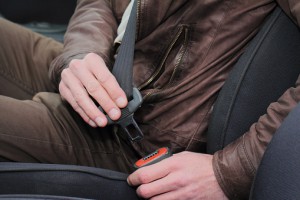Using a Seat Belt: A safety priority on- and off-the-job
Posted on byShare Roads Safely is this week’s emphasis for National Safety Month. Motor vehicle safety is an important topic in the workplace as motor vehicle crashes are the leading cause of fatal injuries among workers in the United States. When it comes to reducing severity of injury or death in a crash, seat belt use can make a big difference. Research shows that using seat belts reduces the risk of fatal injuries to front seat occupants of cars by 45% and the risk to light truck occupants by 60%. [NHTSA]
NIOSH recently released a publication focused on estimating seat belt use among adult workers in 21 U.S. states. Although the analysis did not specifically address work-related seat belt use, respondents did provide information about their occupation at the time of the interview. This analysis provides the first estimates of seat belt use among a wide variety of occupational groups. The report shows that overall, the percentage of individuals who reported they did not always use a seat belt was higher (23.6%) in states with secondary belt laws (i.e., where drivers can be ticketed for not using a seat belt only if stopped for another offense) compared to 10.4% in states with primary seat belt laws (i.e., where drivers can be ticketed solely for not using a seat belt).
For every occupational group, the percentage of workers who reported they did not always use a seat belt was higher in states with secondary seat belt laws. There was considerable variation among occupational groups in both primary- and secondary-law states. In primary-law states, the percentage of workers who reported not always using a seat belt ranged from 5.4% in business and financial occupations to 18.0% in construction and extraction occupations. In secondary-law states, the percentage of workers who did not always use a seat belt ranged from 8.1% in the life, physical and social sciences occupations to 55.5% in farming, forestry and fishing occupations.
States, employers, safety advocates, and workers share the responsibility for keeping workers safe on the road.
- States can increase seat belt use through primary enforcement seat belt laws that allow a police officer to pull over and ticket a driver or passenger for not wearing a seat belt.
- Employers can establish comprehensive motor vehicle safety programs that require seat belt use at all times for all vehicle occupants (i.e., drivers and passengers) and reinforce seat belt safety in training meetings.
- Safety advocates can develop additional interventions directed at workers in occupational groups with the lowest self-reported seat belt use.
- Workers can use seat belts on every trip – no matter how short – and make sure passengers buckle up, too.
Join us for the #DriveSafe4Life Twitter chat, co-hosted by the National Safety Council, on June 28 from 1-2 p.m. ET. Follow @NIOSH_MVSafety for work-related motor vehicle safety tips!
Rosa L. Rodriguez-Acosta, PhD, Assistant Director, NIOSH Center for Motor Vehicle Safety, Division of Safety Research
Winnie Boal, MPH, is an epidemiologist in the NIOSH Division of Surveillance, Hazard Evaluations and Field Studies
For more information:
NIOSH’s Motor Vehicle Safety at Work webpage for resources on related topics including distracted driving.
CDC’s Vital Signs: Motor Vehicle Crash Injuries and Trucker Safety: Using a Seat Belt Matters.
National Safety Council: My Car Does What?
Posted on by


